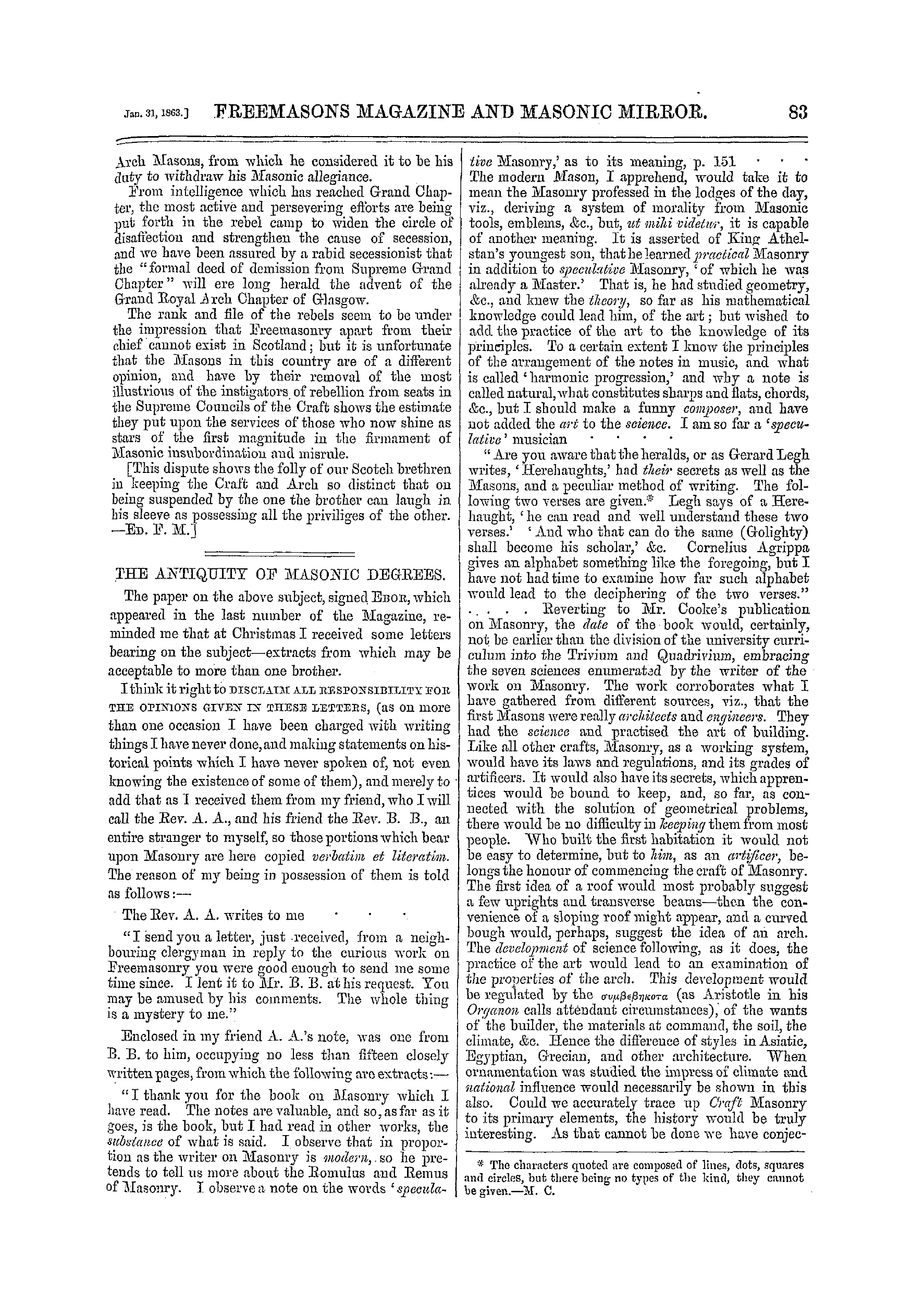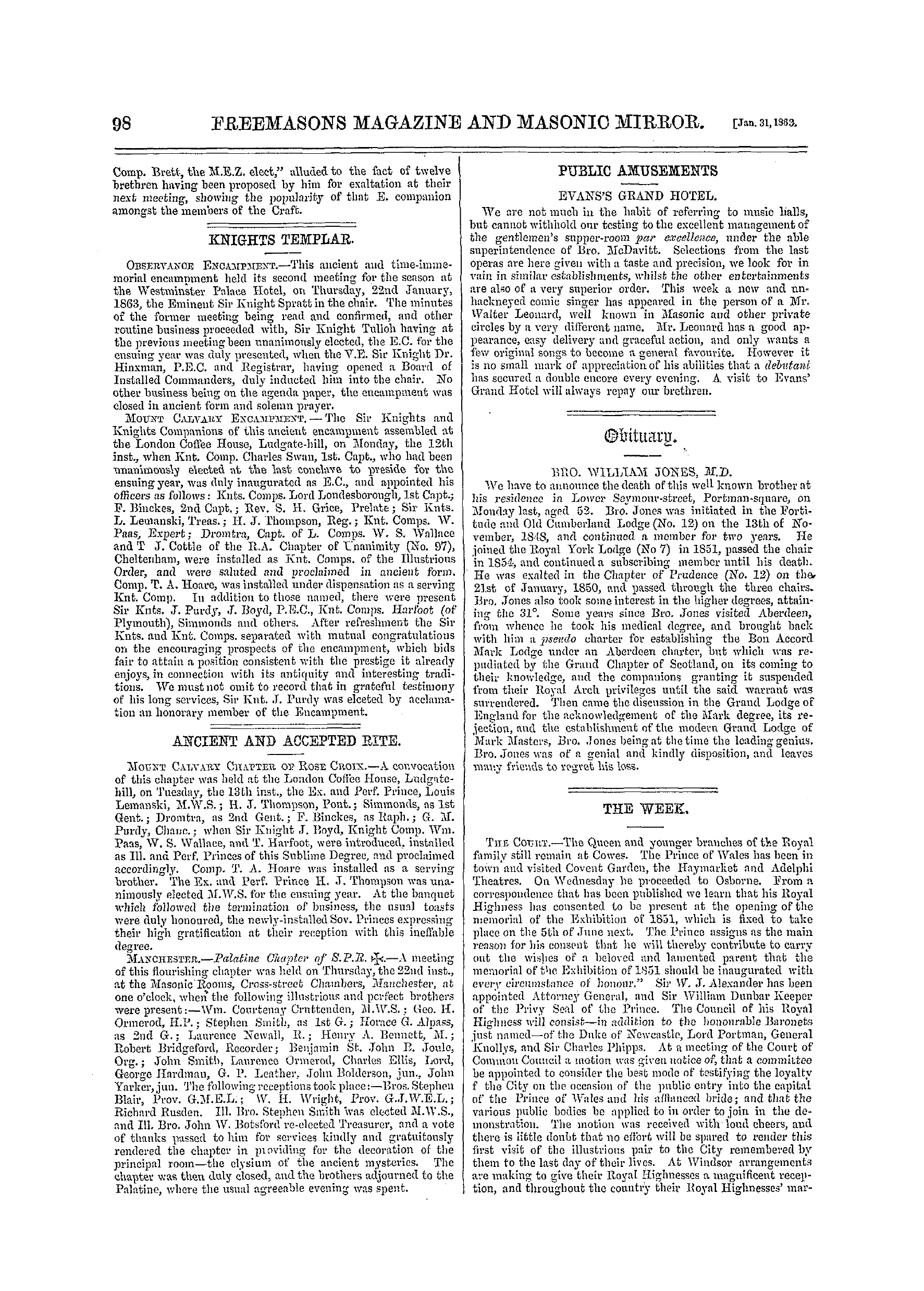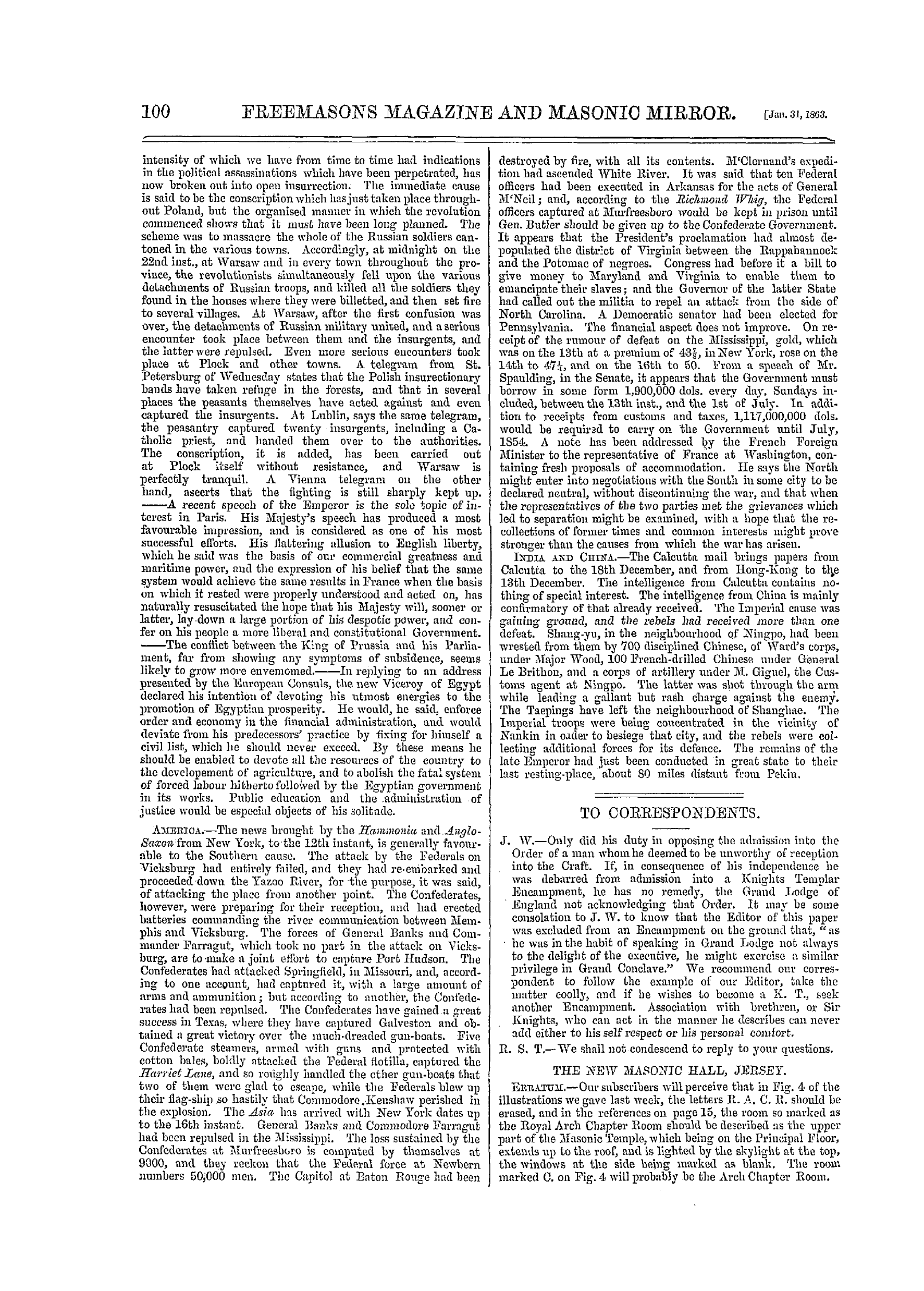-
Articles/Ads
Article MASONIC NOTES AND QUERIES. ← Page 2 of 2 Article CORRESPONDENCE. Page 1 of 2 →
Note: This text has been automatically extracted via Optical Character Recognition (OCR) software.
Masonic Notes And Queries.
Knipe ? Undoubtedly Dr . Thomas Knipe was a contemporary with Elias Ashmole ; but it has been pointed out to me that it could not have been Dr . Thomas Knipe who is said to have written to the publisher , since he died in 1711 ; but that if a vera persona wrote the letter , it was probably Mr . Richard Knipe . I am assured on the best local authority that there ai-e no letters of Dr .
Thomas Knipe in the Bodliean Library , and that no MS . whatever on Masonry has yet turned up in the Ashmole collection . —A . F . A . WOODI-OED , Swillingfcon , Leeds , Jan . 26 th , 1863 .
WAERAXTS OP THREE KEKTISH LODGES . A brother , "Fellow of the Society of Antiquaries , London , " makes an inquiry with a view to some county history respecting- the warrants in virtue of which certain of the lodges in the province of Kent are held . The nature of this inquiry sufficiently appears by the only answer I can give . It is taken from notes
accidentally preserved , and which comprise none but the Canterbnrj' -, Hythe , and Dover warrants . Tho Canterbury warrant is founded on a warrant ( No . 24 ) under date the 7 th April , 1755 , for a lodge held at Bristol . The Hythe warrant is tbe transfer of a warrant dated the 9 th April , 1771 , to form and hold a lodge at the sign of the " Pelican , " or elsewhere , in the City of Bath . The
Dover warrant is the transfer of a warrant , dated 22 nd February , 1791 , to hold a lodge at the " Castle" Inn , or elsewhere , in the town of Maidstone . —CHARLES BURTON COOPER , Chateau Erampas , 20 th January , 186 S .
TEMPLART . At the period of the persecution , some of the Temple Knights deposed to a lawful , and unlawful ceremony of reception . Might not the "lawful" reception be the Christian degree of Masonry , the vere-adeptus of the Rosicrucians ( or , perhaps , the chivalric degree only , which would become necessaryas the order was divided
, , into three distinct classes . And the " unlawful" our present initiatory ceremonies . The easy way in which the noviciate was dispensed with , was one of the great charges against the Order . Some of brethi * cn , in these days , appear wishful again to dispense with the " unlawful " noviciate . —/\ .
SIB WILLLUI WILSON . In reply to Bro . Hyde Clarke ' s query , I enclose a notice of Sir Wm . Wilson , from a little local history * published by a worthy brother Mason . I may add that I have somewhere a copy of the now nearly effaced inscription , which I will communicate when I can lay my hand upon it . — " Jane , the widow of Henry Pudsey , made
a second marriage with Mr . William Wilson . Ho was born at Leicester , and was a builder and architect . After his marriage he resided at Sutton , and continued this business . His wife ' s influence obtained knighthood for bim in 1681 . In 1604 , a fire at Warwick having destroyed the greater part of St . Mary ' s Church , Sir William Wilson was selectedby the Crown Commissioners
to re-construct it ; and to him must be attributed the censure and the praise which the fine proportions but the incongruous detail of this singular building , have so frequently and so loudly called forth . He was ' employed by Lord Efolliott to build Tour Oaks Hall . He also built Nottingham Castle ; and , for his own residence , the house at Sutton , which is possessed and occupied by Perkins
W . D . , Esq . ; and lie was tbe sculptor of the statue of Charles II . at the west front of Lichfield Cathedral . He died iu 1710 , in his 70 th year , but was not allowed sepulture in the Pudsey vault of the church , and was buried near it outside , where , upon the north wall a mural monument was placed to his memory by his nephew , Mr . John Bunios . Its inscription is now nearly effaced . —W . K . R . B .
Correspondence.
CORRESPONDENCE .
The Editor is not responsible for ihe opinions expressed by Correspondents . ANTIQUITY OE MASONIC DEGREES .
IO THE EDITOK OP THE FKEE 3 TASOXS MAGAZIXE AUD MASONIC ailKEOH . DEAE SIR AND BKOTIIEE , —I have little cause to dispute with " Ebor , " though , somewhat , hypercritical , since he partially admits what I contend for ; we each , as is natural , give the pre-eminence to our own favourite element .
I freely admit that Ashmole was admitted a member of a lodge of Freemasons ( Operative ) , but this does not prove that , at this time , there were no strictly speculative lodges , differing in ceremonies , ( the Templar York rite of perfection , vide the reception of the old charges ; an additional word or a mark for F . C , and the degree of
a Mark Master ); or that Speculative Masonry sprung from Operative . Is Architecture the parent of Geometry , or Geometry of Architecture ? Was there not a strictly Speculative lodge established at Cairo in the 11 th century ? We are informed by the writer of Ashmole ' s life , that ,
" He ( Mr . Ashmole ) was elected a brother of the company of Freemasons ; a favour esteemed , so singular , by the members , that kings themselves have not disdained to enter themselves of this society . From these are derived ( the opinion ofthe contemporaries of Bro . Ashmole ) , the Adopted Masons , Accepted Masons , or Freemasons ; who are known , to one another , all over the world , by certain signals and watch words , known to the m alone , & c . "
I have , at various times , with great disappointment , gone carefully over the old constitutions , without beingable to find ; the resemblance to Masonry of the York rite , which the imagination of " Ebor " has led him to observe , but which partial resemblance , I admit , becomes strengthened towards 1700 . A reference to vol . iv . of
this MAGAZINE , page 348 , will show who is wrong , as to the signs of the Craft Freemasons . Until we know something more of the " tradition " of the trades union mentioned , " Ebor ' s " statement is of little value ; and for several reasons , I doubt his knowledge of ancient Templar traditions , and I reiterate the assertion he
disputes . Letthose of your readers who are acquainted with the traditional claims of the Templars , and those of the Old York Masons , reason out the consequence , and judge between us . With respect to the historical part of my argument , I think the testimony of Elias Ashmole ( Hist . Orel . Garter ) Mason , Rosicrucian , and Antiquary ) is no bad crutch for either " Ebor " or " Delta " to lean
upon . I feel convinced that future research will prove the assertion , that , as far as York is concerned , the Templars continued their principles and ceremonies ( were they at all likely to abandon them ?) in the monasteries , and that at the reformation the policy of the government
compelled them to adopt new subterfuges , that they reconstituted themselves and became more intimately connected with the trade guilds , and their distinctive ceremonies gradually suppressed those ofthe latter , in fact becoming adopted , or accepted by them . There can , I should think , be little doubt that Masonry
Note: This text has been automatically extracted via Optical Character Recognition (OCR) software.
Masonic Notes And Queries.
Knipe ? Undoubtedly Dr . Thomas Knipe was a contemporary with Elias Ashmole ; but it has been pointed out to me that it could not have been Dr . Thomas Knipe who is said to have written to the publisher , since he died in 1711 ; but that if a vera persona wrote the letter , it was probably Mr . Richard Knipe . I am assured on the best local authority that there ai-e no letters of Dr .
Thomas Knipe in the Bodliean Library , and that no MS . whatever on Masonry has yet turned up in the Ashmole collection . —A . F . A . WOODI-OED , Swillingfcon , Leeds , Jan . 26 th , 1863 .
WAERAXTS OP THREE KEKTISH LODGES . A brother , "Fellow of the Society of Antiquaries , London , " makes an inquiry with a view to some county history respecting- the warrants in virtue of which certain of the lodges in the province of Kent are held . The nature of this inquiry sufficiently appears by the only answer I can give . It is taken from notes
accidentally preserved , and which comprise none but the Canterbnrj' -, Hythe , and Dover warrants . Tho Canterbury warrant is founded on a warrant ( No . 24 ) under date the 7 th April , 1755 , for a lodge held at Bristol . The Hythe warrant is tbe transfer of a warrant dated the 9 th April , 1771 , to form and hold a lodge at the sign of the " Pelican , " or elsewhere , in the City of Bath . The
Dover warrant is the transfer of a warrant , dated 22 nd February , 1791 , to hold a lodge at the " Castle" Inn , or elsewhere , in the town of Maidstone . —CHARLES BURTON COOPER , Chateau Erampas , 20 th January , 186 S .
TEMPLART . At the period of the persecution , some of the Temple Knights deposed to a lawful , and unlawful ceremony of reception . Might not the "lawful" reception be the Christian degree of Masonry , the vere-adeptus of the Rosicrucians ( or , perhaps , the chivalric degree only , which would become necessaryas the order was divided
, , into three distinct classes . And the " unlawful" our present initiatory ceremonies . The easy way in which the noviciate was dispensed with , was one of the great charges against the Order . Some of brethi * cn , in these days , appear wishful again to dispense with the " unlawful " noviciate . —/\ .
SIB WILLLUI WILSON . In reply to Bro . Hyde Clarke ' s query , I enclose a notice of Sir Wm . Wilson , from a little local history * published by a worthy brother Mason . I may add that I have somewhere a copy of the now nearly effaced inscription , which I will communicate when I can lay my hand upon it . — " Jane , the widow of Henry Pudsey , made
a second marriage with Mr . William Wilson . Ho was born at Leicester , and was a builder and architect . After his marriage he resided at Sutton , and continued this business . His wife ' s influence obtained knighthood for bim in 1681 . In 1604 , a fire at Warwick having destroyed the greater part of St . Mary ' s Church , Sir William Wilson was selectedby the Crown Commissioners
to re-construct it ; and to him must be attributed the censure and the praise which the fine proportions but the incongruous detail of this singular building , have so frequently and so loudly called forth . He was ' employed by Lord Efolliott to build Tour Oaks Hall . He also built Nottingham Castle ; and , for his own residence , the house at Sutton , which is possessed and occupied by Perkins
W . D . , Esq . ; and lie was tbe sculptor of the statue of Charles II . at the west front of Lichfield Cathedral . He died iu 1710 , in his 70 th year , but was not allowed sepulture in the Pudsey vault of the church , and was buried near it outside , where , upon the north wall a mural monument was placed to his memory by his nephew , Mr . John Bunios . Its inscription is now nearly effaced . —W . K . R . B .
Correspondence.
CORRESPONDENCE .
The Editor is not responsible for ihe opinions expressed by Correspondents . ANTIQUITY OE MASONIC DEGREES .
IO THE EDITOK OP THE FKEE 3 TASOXS MAGAZIXE AUD MASONIC ailKEOH . DEAE SIR AND BKOTIIEE , —I have little cause to dispute with " Ebor , " though , somewhat , hypercritical , since he partially admits what I contend for ; we each , as is natural , give the pre-eminence to our own favourite element .
I freely admit that Ashmole was admitted a member of a lodge of Freemasons ( Operative ) , but this does not prove that , at this time , there were no strictly speculative lodges , differing in ceremonies , ( the Templar York rite of perfection , vide the reception of the old charges ; an additional word or a mark for F . C , and the degree of
a Mark Master ); or that Speculative Masonry sprung from Operative . Is Architecture the parent of Geometry , or Geometry of Architecture ? Was there not a strictly Speculative lodge established at Cairo in the 11 th century ? We are informed by the writer of Ashmole ' s life , that ,
" He ( Mr . Ashmole ) was elected a brother of the company of Freemasons ; a favour esteemed , so singular , by the members , that kings themselves have not disdained to enter themselves of this society . From these are derived ( the opinion ofthe contemporaries of Bro . Ashmole ) , the Adopted Masons , Accepted Masons , or Freemasons ; who are known , to one another , all over the world , by certain signals and watch words , known to the m alone , & c . "
I have , at various times , with great disappointment , gone carefully over the old constitutions , without beingable to find ; the resemblance to Masonry of the York rite , which the imagination of " Ebor " has led him to observe , but which partial resemblance , I admit , becomes strengthened towards 1700 . A reference to vol . iv . of
this MAGAZINE , page 348 , will show who is wrong , as to the signs of the Craft Freemasons . Until we know something more of the " tradition " of the trades union mentioned , " Ebor ' s " statement is of little value ; and for several reasons , I doubt his knowledge of ancient Templar traditions , and I reiterate the assertion he
disputes . Letthose of your readers who are acquainted with the traditional claims of the Templars , and those of the Old York Masons , reason out the consequence , and judge between us . With respect to the historical part of my argument , I think the testimony of Elias Ashmole ( Hist . Orel . Garter ) Mason , Rosicrucian , and Antiquary ) is no bad crutch for either " Ebor " or " Delta " to lean
upon . I feel convinced that future research will prove the assertion , that , as far as York is concerned , the Templars continued their principles and ceremonies ( were they at all likely to abandon them ?) in the monasteries , and that at the reformation the policy of the government
compelled them to adopt new subterfuges , that they reconstituted themselves and became more intimately connected with the trade guilds , and their distinctive ceremonies gradually suppressed those ofthe latter , in fact becoming adopted , or accepted by them . There can , I should think , be little doubt that Masonry



















